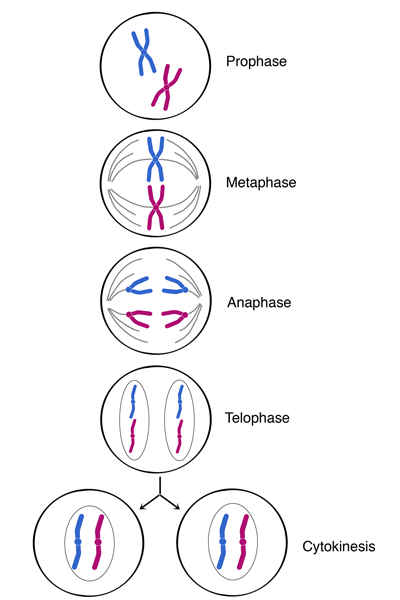Under an electron microscope parts of the animal cell such as the ribosomes, endoplasmic reticulum and mitochondria can be seen. Examiners often like to ask this question.
The main differences between a plant cell and an animal one are the lack of certain organelles such as a permanent vacuole, cell wall and chloroplast. Apart from this plant cells also have a more regular structure.
The Functions of the parts of the cell:
Nucleus: contains chromosomes (46 in humans) which carry the genetic information. It controls the activity of the cell by controlling which proteins the cell will synthesise.
Cytoplasm: this is where chemical reactions occur.
Cell membrane: this controls what substances can pass in and out of the cell. It is selectively permeable.
Cell wall: this protects the cell and helps support itself.
Chloroplasts: these are needed for photosynthesis to take place in plants.
Mitochondria : this carries out some of the reactions in respiration.
Endoplasmic reticulum: an essential component in the synthesis and transport of protein. It is a network of membranes.
Ribosomes: some endoplasmic reticulum are covered with minute granules called ribosomes. These build and assemble proteins according to instructions from mRNA.
DNA
DNA or deoxyribonucleic acid contains two strands of alternating sugar and phosphate groups coiled to form a double helix. The strands are linked by two nitrogen bases at each "rung". There are four different bases: Adenine(A), Thymine(T), Cytosine(C), and Guanine(G). In DNA the bases are always paired. So if on one strand the base is A, the other must be T and likewise if on one strand it is C then on the other it must be G.
 |
| A simplified version of a DNA molecule. |
Mitosis is a process of separating a cell into two with identical sets of chromosomes. This occurs during growth, repair, cloning and asexual reproduction.
- Prophase - the cell duplicates it DNA.
- Metaphase - the chromatids (duplicated chromosome) align themselves along the equator (middle) and send out tubules that connect to the centromere which connect the two strands of chromosomes (condensed DNA).
- Anaphase - half of the chromosomes are pulled one way and vice versa.
- Telophase - cell membranes closes in and splits the cell.
The organisation of cells:
Specialised cells that perform similar functions are grouped together as tissues:
There are many types of tissues:
- Bones - collection of cells that secrete calcium salts.
- Muscle - these can be voluntary, involuntary or also cardiac.
- Blood - collection of red and white blood cells.
- Nervous tissue - makes up the brain, nerves and spinal cord.
- Epithelium - these are tissues that line organs. They can be both squamous or ciliated.
Tissues that perform the same function are grouped together to form organs. e.g. Heart.
Organs that perform the same function are grouped together to form organ systems. e.g. Circulation system
Organ systems are grouped together to form organisms. e.g. Humans.


Thank you so much for share such a wonderful article.I like the way of writing and also the author clearly describe all the parts of the article with good language and information.Waiting for new stuff.custom essay writing services
ReplyDeleteIn the illustartion above..the animal cell has a cell wall!!!
ReplyDeleteIn the illustartion above..the animal cell has a cell wall!!!
ReplyDeleteI've now changed it thanks for letting me know
DeleteArent they the centromeres* of the chromosomes that align along the equator, the centrioles only move to the opposite poles
ReplyDeleteYes you're right I'll change it
Deletereally helped me out. Great work and Thanks!!!
ReplyDeleteYou're welcome!
DeleteAwesome notes!!!
ReplyDeleteThanks =D
No problem!
DeleteAwesome notes!!!
ReplyDeleteThanks =D
With what grades you cleared igcse biology?
ReplyDeleteWhich is your grade in igcse?
ReplyDeletethx for the notes!!
ReplyDeleteDoes this web has all the topic on igcse edexcel human bio ??